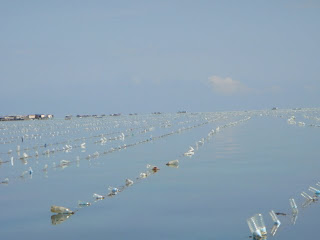
Researchers have known for several years that after a person ingests a drug, their body may excrete residues of the chemical that remain biologically active. Thus, internal drug use, combined with improper disposal of unused drug stores, has been blamed for residues of everything from antibiotics to painkillers to hormones found in municipal and natural water supplies across the country. Because drugs are specifically designed to produce biological effects at very low concentrations, this pollution is considered a major threat to human and environmental health.
A study conducted by researchers from the Environmental Protection Agency (EPA) and Touro University in Henderson, Nev., and presented at the American Chemical Society annual meeting in San Francisco has shown that the shower and washing machine may be even more potent sources of pharmaceutical pollution than the toilet.
"We've long assumed that the active ingredients from medications enter the environmental as a result of their excretion via urine and feces," study co-author Ilene Ruhoy said. "However, for the first time, we have identified potential alternative routes for the entry into the environment by way of bathing, showering and laundering. These routes may be important for certain APIs found in medications that are applied to the skin." she said.
"They include creams, lotions, ointments, gels and skin patches." The researchers reviewed hundreds of studies analyzing the body's use and metabolism of drugs, and concluded that drugs including acne medicine, antimicrobials, narcotics and steroids are entering the water system by being washed directly from people's skin in baths and showers. In addition, many medications dissolve in sweat and wash off the body into people's clothing, only to enter the water system when those clothes are laundered.
It is the first study to show a link between bathing or laundering and pharmaceutical pollution. In contrast to ingested drugs, which are broken down by the liver and kidneys and then released in less-potent form, drugs that wash off the human body enter the water completely unmodified.
"Topical [active pharmaceuticals] from bathing and showering are released unmetabolized and intact, in their full-strength form," Ruhoy said."Therefore, their potential as a source of pharmaceutical residues in the environment is increased."
The EPA further encourages consumers to always properly dispose of all medications, carefully reading the information on drug labels and accompanying documentation, and taking advantage of drug take-back or hazardous waste disposal programs where they live. In areas without take-back or household collection programs, state or local waste management authorities should be able to provide guidelines for disposal of pharmaceutical products.
Protecting water from household pollution need not end with pharmaceuticals. The EPA advises that consumers use non-toxic household cleaners and other chemicals wherever possible, and limit pesticide and other toxin use. Leftover chemicals should never be disposed of by flushing!



